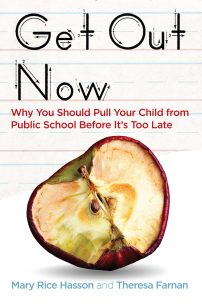In Get Out Now: Why You Should Pull Your Child from Public School Before It’s Too Late, Mary Rice Hasson and Theresa Farnan sound a wake-up call to parents with children in public schools. They delineate a number of alarming problems in the public schools, attributing the causes to those with progressive agendas who control what goes on in those schools. According to the authors, “The truth is that nearly everything in America’s public schools—the culture, discipline, curriculum hiring practices, school policies, even the names of schools themselves—is determined by progressive ideologues, both inside and outside the school systems” (p. xi). Hasson and Farnan believe that progressives have thoroughly and successfully infiltrated the schools with their worldview: “Public education has been incredibly successful in one area: churning out youthful progressives—growing numbers of men and women in the grips of existential confusion, perpetual victimhood, and political intolerance” (p. xii).
A large part of Get Out Now is devoted to explaining problems within schools, with the authors’ recommended solutions almost a footnote. The body of the book is presented in two main sections: “The Game Changer: The Gender Crusade” and “More Trouble.” The first part clearly focuses on gender issues, detailing issues such as programs designed to change students’ attitudes regarding gender issues, legal requirements (both nationally and in various states), activist organizations that advance the LGBT agenda and their influence within schools, and the enforced participation of teachers.
The second section of the book covers a host of other issues that might be of equal or greater concern. One chapter addresses the undermining of faith that takes place in schools, particularly with the elevation of science as the source of truth. Another chapter reveals how schools have shifted from a primary goal of raising patriotic citizens in favor of encouraging activism with a global emphasis.
The following chapter explains how schools have altered their view of relationships within the three-way triangle between schools, parents, and children. Parents have little or no say over what happens with their children while they are in school. Children are viewed as autonomous beings with rights that override parental preferences and even the right of parents to know what is happening with their own children in regard to medical care. And school personnel are viewed as protectors and defenders of children, even when there is a conflict with parental preferences.
Other chapters in this section address topics such as identity politics, the encouragement of extreme sensitivity to microaggressions, safe spaces, psychological profiling, and speech codes. These other priorities seem to have displaced what many parents still think is the purpose of schooling: education in academic subjects. Hasson and Farnan demonstrate this by pointing out the dismal academic results as reflected in tests scores on the Department of Education’s National Assessment of Education Progress.
In the final chapter, “You Cannot Fix These Problems,” Hasson and Farnan explain why public education is beyond the capacity of parents to rescue. In the penultimate paragraph, they urge parents to remove their children from these schools, and they urge religious leaders and pastors to support other education options such as “hybrid models, online learning, cooperative schools, homeschooling, and faith-based schools.” Then they add a recommendation to social and political conservatives, encouraging them to promote: “meaningful school choice, including vouchers, educational savings accounts, and any other options that the free market and American ingenuity can devise” (p. 177-178). In the 18-page appendix that follows this chapter, Hasson and Farnan push more specifically for government-funded educational vouchers that can be used to pay student tuition at religious schools.
While the authors accurately identify problems, and I agree that parents need to remove their children from government schools, I think their recommendation of vouchers is misguided. Vouchers have been around long enough that we can already see how they have caused voucher-receiving schools to remove or compartmentalize their religious character. Vouchers have the potential to reduce private schools to the same level as their public school counterparts. (You can read my review of Vouchers Within Reason for more on that topic.)
In summary, the situation in public schools continues to deteriorate, yet too many parents seem oblivious. The problems are not new, but they have gotten significantly more dangerous to the health and well-being of children. Hasson and Farran are effectively sounding the alarm, but I suspect that most parents will not be able to overcome the inertia of the status quo until something awful happens to their own child. What more will it take to convince parents that leaving their children in public schools is probably placing them in harm’s way?









